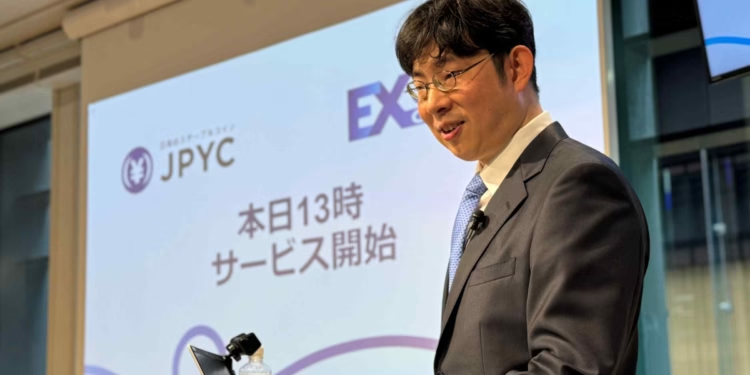Japanese stablecoin issuer JPYC plans to invest up to 10 trillion yen ($66.3 billion) in Japanese government bonds over the next three years as it scales issuance of its yen-backed digital currency.
The company aims to position itself as a major JGB holder as the Bank of Japan reduces its bond-buying programs, with CEO Noritaka Okabe telling Reuters that stablecoin issuers could emerge as significant bond market participants and indirectly influence monetary policy.
JPYC’s Strategic Vision for Yen-Pegged Stablecoin Expansion
In a bold forecast, JPYC disclosed that it aims to issue 10 trillion yen (approximately $66.3 billion) worth of JPYC tokens over the next three years. Currently, the yen-pegged stablecoin issuer has already issued nearly 143 million yen worth of tokens, attracting over 4,700 account holders as of mid-November.
While the JPYC project remains a fraction of the $290 billion global stablecoin market, the company believes it can carve out a critical niche for the yen amid the overwhelming dominance of U.S. dollar-backed stablecoins, which currently control nearly 99% of global supply.
Speaking with Reuters, JPYC’s CEO Noritaka Okabe emphasized that blockchain-based asset trading is expanding rapidly — yet the dominance of the U.S. dollar presents economic challenges for Japanese firms.
“The U.S. dollar’s dominance in stablecoins puts Japanese companies at a disadvantage due to higher transaction and hedging costs,” said Okabe. “Japan must ensure the yen has a presence in the global stablecoin market.”
The yen-pegged stablecoin issuer said its tokens are fully convertible to yen and backed by domestic savings and Japanese government bonds (JGBs). JPYC plans to allocate 80% of its proceeds into JGBs and 20% into bank savings, reflecting a balanced approach to liquidity and national economic support.
Yen-Pegged Stablecoin Issuers Could Influence BOJ’s Policy
Okabe believes that stablecoin issuers may soon emerge as major holders of JGBs, especially as the BOJ reduces its bond-buying programs after years of quantitative easing.
“With the BOJ tapering bond buying, stablecoin issuers could emerge as the biggest holders of JGBs in the next few years,” said Okabe.
Currently, the Bank of Japan still holds 50% of the 1,055-trillion-yen JGB market, but its reduced purchases have opened space for private and fintech-backed initiatives like JPYC.
The yen-pegged stablecoin issuer sees this as an opportunity to fill the gap left by the BOJ while indirectly shaping monetary policy through market dynamics. Okabe noted that the demand and supply balance for stablecoins directly affects how many bonds these issuers can purchase.
At present, JPYC is prioritizing short-term securities, but the company revealed that policymakers and lawmakers have encouraged it to consider longer-term bond purchases.
Okabe hinted at future diversification:
“We’ve been approached by officials about buying longer-term JGBs. It’s something we can explore as our market position strengthens.”
He also disclosed that Japan’s three largest banks plan to jointly experiment with issuing their own stablecoins, signaling a coordinated national effort to expand yen-backed digital assets.
Regulatory Support and Growing Innovation
The Financial Services Agency (FSA) of Japan has created a regulatory sandbox to foster innovation in digital finance, easing compliance risks for stablecoin developers.
According to industry analysts, JPYC’s partnerships and megabank collaborations could accelerate the yen’s adoption in cross-border transactions, enhancing liquidity and boosting global confidence in Japan’s digital economy.
Despite concerns from policymakers that stablecoins could facilitate fund movement outside traditional banking systems, Okabe maintains that responsible regulation will ensure stability. He argues that properly managed yen-pegged stablecoin issuers will strengthen, not undermine, the financial system.
JPYC’s massive investment plan underscores Japan’s determination to reclaim monetary influence in the global stablecoin market.
As the yen-pegged stablecoin issuer expands its footprint, it could reshape Japan’s bond market, drive financial innovation, and reduce reliance on the U.S. dollar — signaling a new era for Japan’s digital economy.











